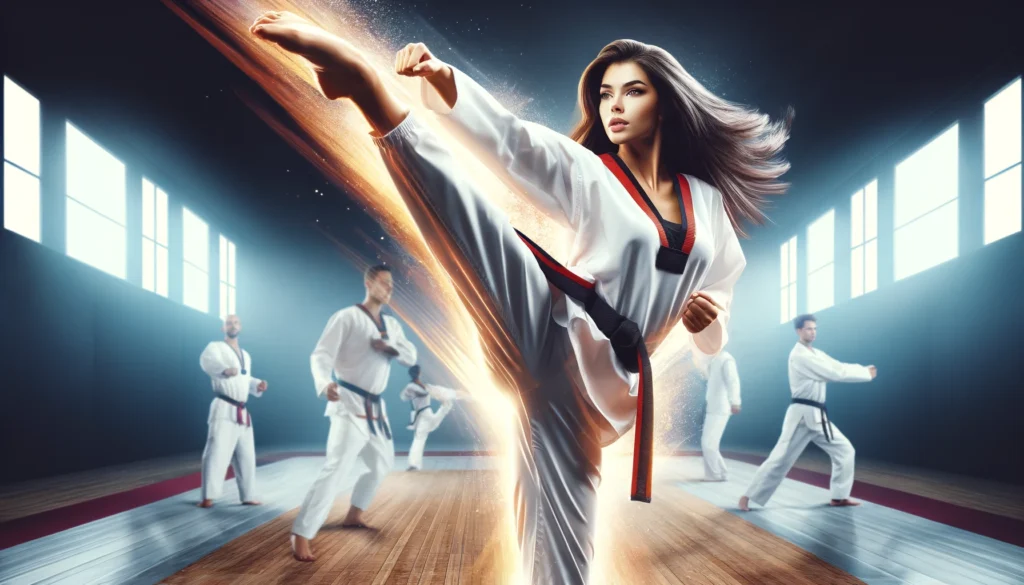Table of Contents
Understanding the Benefits of High Kicks in Taekwondo Training
High kicks are a hallmark of Taekwondo, showcasing flexibility, strength, and precision. However, while they are impressive in demonstrations and competitions, their practicality in self-defense, particularly in street fights, is often debated. Let’s explore the dynamics of high kicks, understanding when and why to train them, and their strategic use in different scenarios.
The Fundamentals of High Kicks
High kicks, such as the roundhouse kick (dollyo chagi) or the axe kick (naeryo chagi), require significant skill and practice. They demand exceptional balance, speed, and flexibility. Here are some fundamental aspects to consider:
- Speed and Distance: High kicks cover more distance, making them slower to execute compared to low kicks. The time it takes for a high kick to reach its target gives an opponent more opportunity to react and counter.
- Vulnerability: During both the delivery and retraction stages of a high kick, a practitioner is more exposed. This vulnerability can be exploited by a savvy opponent, especially in the chaotic environment of a street fight.
- Multiple Opponents: Street fights rarely follow the structure of a one-on-one sparring match. The presence of multiple opponents increases the risk associated with high kicks, as they leave you open to attacks from various angles.
- Environmental Factors: Real-world situations often involve obstacles such as furniture, crowds, or uneven terrain. These factors can hinder the effectiveness and safety of high kicks.
The Value of Training High Kicks
Despite the potential drawbacks in self-defense scenarios, training high kicks should not be overlooked. Here’s why they still hold value:
- Flexibility and Strength: Practicing high kicks enhances overall flexibility and leg strength. These attributes contribute to better performance in low and mid-level kicks, which are more practical in self-defense.
- Technique and Control: High kicks require precise technique and control, skills that translate to improved performance in all kicking techniques. The discipline developed through high kick training can enhance overall martial arts proficiency.
- Versatility in Sparring and Competitions: In Taekwondo competitions, high kicks can be strategic tools for scoring points and demonstrating technical prowess. They add an element of surprise and can be highly effective when used at the right moment.
- Mental Toughness: The physical and mental challenges of mastering high kicks build resilience and determination. Overcoming the difficulties of high kick training can boost confidence and perseverance in martial arts practice.
Strategic Use of High Kicks
Understanding when and how to use high kicks is crucial. Here are some scenarios where they can be advantageous:
- Distance Management: High kicks can be used to keep an opponent at a distance, especially when they are taller or have a longer reach.
- Surprise Element: In sparring or controlled environments, a well-timed high kick can catch an opponent off guard, breaking their rhythm and creating openings for other techniques.
- Demonstrations and Forms: High kicks are impressive in demonstrations and forms (poomsae), showcasing the aesthetic and technical aspects of Taekwondo.
Conclusion: Balancing Training and Practicality
While high kicks may not be the most practical choice in a street fight, their value in training, competition, and demonstrations is undeniable. They contribute to overall martial arts development, enhancing flexibility, strength, and technical skill. For self-defense, prioritizing low and mid-level kicks, which are faster and more stable, is advisable. However, maintaining a well-rounded training regimen that includes high kicks ensures a comprehensive martial arts education and prepares practitioners for a variety of scenarios.
At Taekwondo4Fitness, we encourage a balanced approach, emphasizing the importance of adaptability and awareness in every situation. Whether you’re training for self-defense, competition, or personal growth, understanding the strengths and limitations of high kicks will make you a more versatile and proficient martial artist. Keep kicking high, but stay grounded in your strategy!







